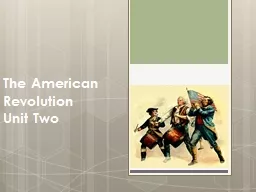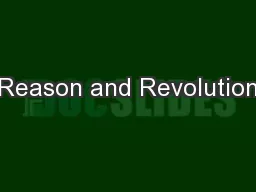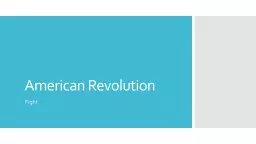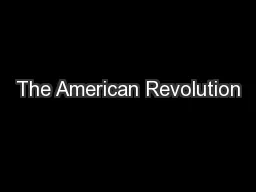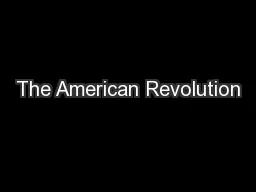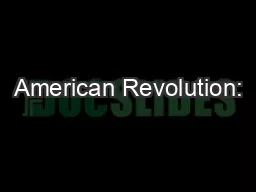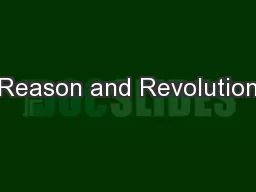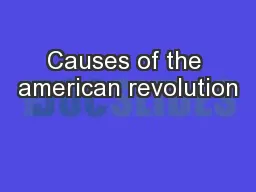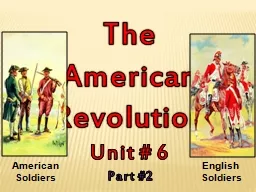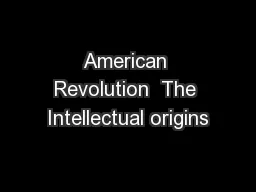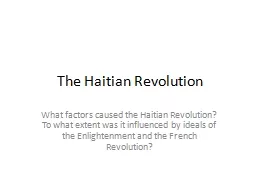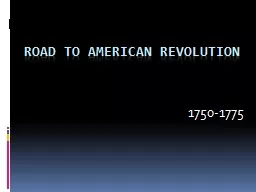PPT-The American Revolution
Author : olivia-moreira | Published Date : 2016-05-11
Unit Two At the end of this unit you should be able to answer the following How did the French and Indian War change the relationship between the British and their
Presentation Embed Code
Download Presentation
Download Presentation The PPT/PDF document "The American Revolution" is the property of its rightful owner. Permission is granted to download and print the materials on this website for personal, non-commercial use only, and to display it on your personal computer provided you do not modify the materials and that you retain all copyright notices contained in the materials. By downloading content from our website, you accept the terms of this agreement.
The American Revolution: Transcript
Unit Two At the end of this unit you should be able to answer the following How did the French and Indian War change the relationship between the British and their American colonies How did the taxes and acts that were passed by the British and enforced in the colonies contribute to the American Revolution Be specific in your answer and describe other factors that contributed to the desire for the colonies to break from England. L/O – To identify and explain the causes and effects of the Revolution. The German Revolution. In late 1918, there was . unrest . across the whole of Germany. The emperor fled for his life and a new government took control. These events are called the . 1750-1800. Representative Government . The idea of representative government was in keeping with the long-standing English traditions of limiting royal power.. Natural Rights. The writings of British philosopher John Locke profoundly influenced America's founding fathers and 18th century thought. Locke justified limiting royal authority and proposed that all human beings have natural rights and are entitled to political and economic freedom regardless of birth. . Fight. Revolution?. What does this word mean?. A sudden and quick change in something. . Often used to describe a radical change in government. Can be peaceful or violent. Can anyone name any other revolutions?. During the American Revolution, the overmatched colonists found a leader in George Washington and badly-needed French assistance after the Battle of Saratoga. When the war ended, the Treaty of Paris in 1783 brought independence and the formation of the United States. . Like the Rebel Alliance in . Star Wars. , the rebels of the American Revolution were a small disorganized group fighting against a giant empire with vastly superior numbers and firepower.. Yet the rebels won anyway, due to massive foreign support, clever strategies, noble leaders, high ideals, propaganda, and a fair amount of foul play. We don't think the Force was involved, although Benjamin Franklin had a bit of a Yoda vibe going.. Build up, overview, results. I can . analyze the declaration of Independence in order to evaluate which Enlightenment Ideas are present in the document.. What is a Contagion? . a : rapid communication of an influence (as a doctrine or emotional state). 1750-1800. Representative Government . The idea of representative government was in keeping with the long-standing English traditions of limiting royal power.. Natural Rights. The writings of British philosopher John Locke profoundly influenced America's founding fathers and 18th century thought. Locke justified limiting royal authority and proposed that all human beings have natural rights and are entitled to political and economic freedom regardless of birth. . By. Nicholas . G.. Social Studies Class - Mr. Stewart. The American Revolution began in 1775 as . an open . conflict between the united 13 colonies and Great Britain. The Treaty of Paris ended the war in 1783, the colonies had won their independence. While no one event can be pointed to as the actual cause of the revolution, the war began as a disagreement over the way in which Great Britain treated the colonies versus the way the colonies felt they should be treated.. Unit # 6. Part #2. American Soldiers. English . Soldiers. The Causes . of the . American revolution. 1763 - 1774. British Government . Versus. British Colonists. Viewing Guide – The American Revolution: From Colonies to Constitution. Intellectual Origins . Write down your opinion to the question: Can ideas cause a revolution? Explain your answer.. Intellectual Origins. Intro:. It is not an uncommon argument (both by historians and others) to suggest that the American Revolution was started by ideas or ideals. Background. Treaty of Ryswick – 1695 . Africans and . engagés. for labor. 1685 – Negro codes – punishments . High mortality / low fertility. Slave population – 500,000 – most African-born. Road to American Revolution 1750-1775 Warm-up for 12/10 and 12/11 Write down your homework and the following question: What can we expect to learn in this Unit based on the following video clip? http://www.youtube.com/watch?v=8OI7itQJpfE Unit 3- American Revolution Covers the Road to Revolution, the Revolution, and effects Monday, 10/12 Warm-up (new sheet page 1 your paper): Take Pre-test on the American Revolution (on paper) Write down your homework: The Old Regime. 1. st. Estate – Clergy - 1% of population. 2. nd. Estate – Nobility – 1% of population. 3. rd. Estate – Remainder of population. The Clergy. Very wealthy and powerful. Owned 10% of the land in France.
Download Document
Here is the link to download the presentation.
"The American Revolution"The content belongs to its owner. You may download and print it for personal use, without modification, and keep all copyright notices. By downloading, you agree to these terms.
Related Documents

